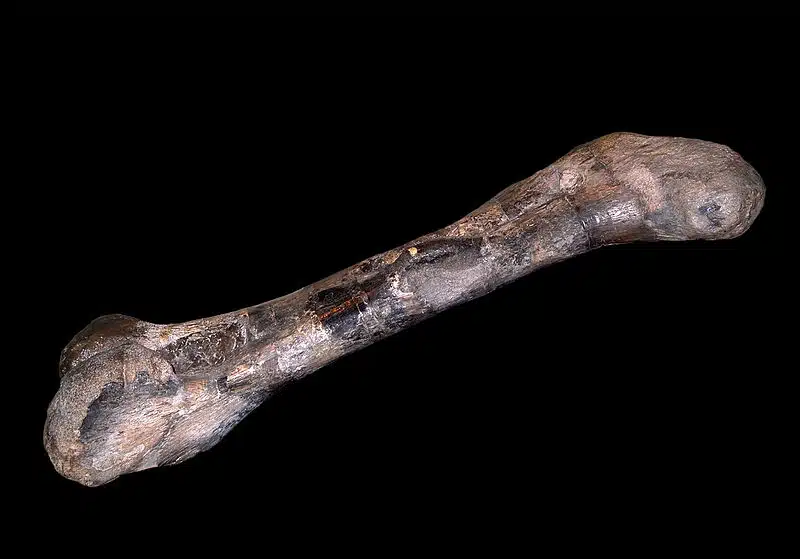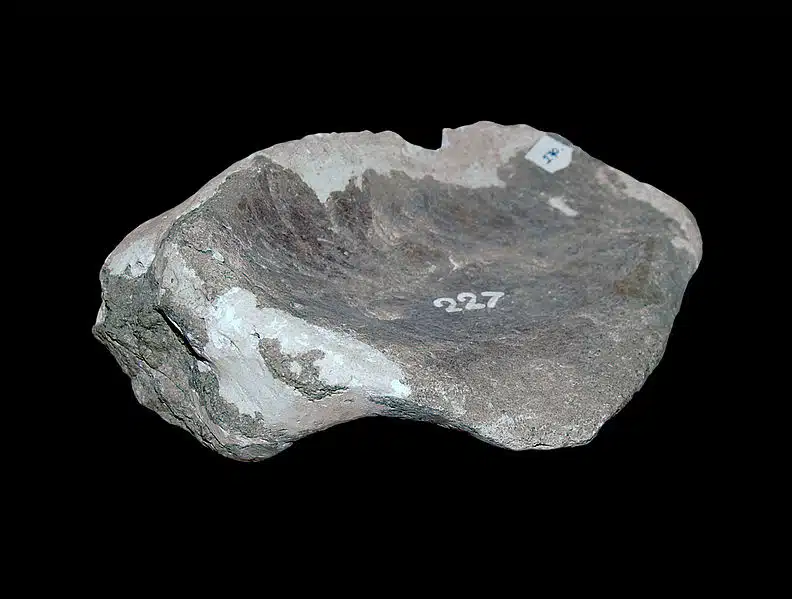Let’s embark on a journey back in time, to an era when the Earth was a vastly different place, teeming with creatures that defy our modern understanding. Among these ancient giants roamed Magyarosaurus, a fascinating sauropod whose story is etched in the rocks and fossils of the Late Cretaceous Period. This dinosaur, whose name pays homage to the Magyar people of Hungary, offers us a unique window into a long-lost world.
Magyarosaurus Key Facts
| Keyword | Fact |
|---|---|
| Pronunciation | Mag-yar-oh-sore-us |
| Meaning of name | Magyar Lizard |
| Group | Sauropoda |
| Type Species | Titanosaurus dacus (syn. M. transsylvanicus, M. hungaricus) |
| Diet | Herbivore |
| When it Lived | 70.6 to 66.0 MYA |
| Period | Late Cretaceous |
| Epoch | Late/Upper Maastrichtian |
| Length | 20.0 feet |
| Height | Approximately 5.0 feet |
| Weight | 1,650.0 to 2,200.0 pounds |
| Mobility | Moved on all four |
| First Discovery | 1895 by Baron Nopcsa |
| Described by | 1915 by Baron Nopcsa |
| Holotype | BMNH R.3861a |
| Location of first find | Hunedoara region, Romania |
Magyarosaurus Origins, Taxonomy and Timeline
Magyarosaurus, or ‘Magyar Lizard’, derives its name from the ancient Hungarian people, coupled with the Greek word ‘sauros’, meaning lizard or reptile. This nomenclature not only honors its discovery location but also fits neatly into the grand lexicon of dinosaur names.

Belonging to the sauropod group, this dinosaur is a member of the nemegtosaurid. Its type species, Magyasaurus dacus, hints at its colossal nature, a common trait among sauropods.
The timeline of Magyarosaurus spans the Late Cretaceous Period, specifically during the Late Maastrichtian. It thrived approximately between 70.6 and 66.0 million years ago, a time when the world was on the cusp of significant changes leading to the extinction of major tetrapod groups.
Listen to Pronunciation
Discovery & Fossil Evidence
The Early Findings and Taxonomic Evolution
The journey to uncovering Magyarosaurus began in the late 19th century with Baron Nopcsa, who initiated fossil collections in the Hunedoara region, then part of Hungary, now western Romania. His efforts, starting from 1895, led to the discovery of remains from at least ten individuals in the Sânpetru Formation. In 1915, Nopcsa named these remains Titanosaurus dacus, a nod to the ancient Dacians who once inhabited the area. However, it was Friedrich von Huene who, in 1932, renamed the species Magyarosaurus dacus, simultaneously introducing two other species: M. hungaricus and M. transsylvanicus. M. transsylvanicus is now a synonym of M. dacus and the existence of M. hungaricus is dubious.
Fossilized Remains and Their Significance
The holotype of Magyarosaurus, labeled BMNH R.3861a, is a set of vertebrae. The fossil record for this dinosaur is quite extensive, including numerous caudal (tail) vertebrae, dorsal (back) vertebrae, and elements of the limbs. Interestingly, no skull remains have been found to date. A remarkable discovery related to Magyarosaurus is the unearthing of 14 fossil eggs, attributed to this species, shedding light on aspects of its reproductive biology.
Paleontological Investigations in Transylvania
Further paleontological explorations, particularly at Râpa Roșie near Sebeş on the southwestern side of the Transylvanian Basin, have enriched our understanding of Magyarosaurus. These investigations, which began in 1969, have unearthed additional dinosaur bones, including rare sauropod caudal vertebrae. The findings at Râpa Roșie are significant as they suggest that Magyarosaurus is the only sauropod genus reported from the latest Cretaceous Maastrichtian formations in Romania. This solitary representation in the region’s fossil record underscores the unique place Magyarosaurus holds in the Late Cretaceous ecosystem of the area
- Humerus, Deva Natural History Museum
- Magyarosaurus sp. scapula
- Limb bone
- Coracoid of Magyarosaurus, Deva Natural History Museum.
Magyarosaurus Size and Description
The Magyarosaurus, a member of the sauropod family, presents a unique case in terms of its physical characteristics. Unlike its larger relatives, this dinosaur was relatively diminutive. It exhibited the typical sauropod features: a long neck and tail, a substantial body, and robust legs. However, what sets it apart is the presence of dermal armor, an unusual trait for sauropods, suggesting a distinct evolutionary path and possibly a different set of survival strategies.
Size and Weight of Type Species
In the realm of sauropods, Magyarosaurus stands out for its smaller stature. It reached a length of approximately 20.0 feet and weighed between 1,650.0 to 2,200.0 pounds. This reduced size is considered an autapomorphy, a unique characteristic distinguishing it from its close relatives. The small size of Magyarosaurus raises intriguing questions about its life and environment, suggesting adaptations to specific ecological niches or resource availability in its habitat. The presence of dermal armor adds another layer of interest, indicating a possible defensive adaptation uncommon in other sauropods.
The Dinosaur in Detail
A defining aspect of this dinosaur is its notable size reduction, a result of insular dwarfism. This phenomenon occurred due to the selective pressures of its island habitat, characterized by limited food resources and a scarcity of predators, both factors favoring smaller body sizes. This form of dwarfism is not unique to Magyarosaurus; it was also observed in contemporaneous species like the ornithopod Rhabdodon and the nodosaur Struthiosaurus. Baron Nopcsa, the discoverer of Magyarosaurus, was the first to propose island dwarfism as the reason for its smaller size. This hypothesis, initially met with skepticism, was later substantiated by a 2010 study examining bone growth patterns, confirming that the smaller individuals were indeed fully grown adults.
Insights from Bone Histology
In 2010, Koen Stein and colleagues delved into the bone histology of Magyarosaurus, revealing significant findings. Their research confirmed that even the smallest specimens were adult individuals. They also maintained the distinction of “M. hungaricus” for larger specimens, which were too big to be considered mere variations of the smaller ones (but this needs to be confirmed and for now only the type species M. dacus is officially recognised). The study highlighted that Magyarosaurus had a reduced growth rate but maintained a high metabolic rate, a combination that further distinguishes it from other sauropods.
Dermal Armor and Its Implications
An intriguing aspect of Magyarosaurus is the discovery of osteoderms, or dermal armor, near Sînpetru village in the Hațeg Basin of Romania. This finding suggests that dermal armor was widespread among Late Cretaceous Sauropods. The unique shape and size of these osteoderms have led to the assignment of certain fossil eggs to the Nemegtosauridae family, and possibly to Magyarosaurus itself.
The Mystery of Possible Eggs
The Hațeg Basin, a significant Late Cretaceous nesting site, has yielded Lithostrotian eggs attributed to the Nemegtosauridae family. These eggs, potentially belonging to Magyarosaurus or Paludititan, with Magyarosaurus being the more likely candidate, add another layer to our understanding of this dinosaur’s life cycle. Discovered during a 2001 field expedition by a Belgo-Romanian team, these eggs, initially thought to be in nests, have been reevaluated, showing no evidence of preserved nesting structures. However, the presence of embryos and indications of dermal armor within one egg provide fascinating insights into the reproductive biology and developmental stages of Magyarosaurus.
Contemporary Dinosaurs
In the ancient world of the Late Cretaceous Period, Magyarosaurus, a relatively small titan of its time, roamed the lands that are now Europe. Despite its classification as a sauropod, Magyarosaurus was a pint-sized giant, dwarfed by its colossal cousins. This diminutive stature, about the size of a modern bus, played a crucial role in its interactions with contemporaries. Among these were Zalmoxes, a robust, beaked herbivore, slightly smaller but more heavily built. The two might have shared grazing grounds, perhaps wandering the same paths, but Magyarosaurus, with its longer neck, likely browsed higher vegetation, leaving the lower shrubs to Zalmoxes.
Struthiosaurus, another contemporary, was a small, ankylosaur armored dinosaur, a mere fraction of Magyarosaurus’s size. These tiny tanks of the Cretaceous could have been seen scuttling underfoot, almost like living rocks amidst the towering legs of Magyarosaurus. It’s fascinating to imagine Magyarosaurus carefully stepping over these little armored creatures, perhaps in a mutual understanding of coexistence, avoiding any unnecessary squabbles over territory.
Then there was Telmatosaurus, a hadrosaur of comparable size to Magyarosaurus. These two might have been seen as equals in their environment, possibly competing for similar food sources. However, their different feeding strategies – Telmatosaurus with its broad, duck-like bill for cropping plants, and Magyarosaurus with its long neck for reaching higher foliage – could have minimized direct competition, allowing a harmonious cohabitation.
Lastly, the presence of Balaur, a predator (theropod) roughly half the size of Magyarosaurus, adds a thrilling dynamic. Balaur, with its two large, sickle-shaped claws on each foot, was a formidable hunter. It’s conceivable that Magyarosaurus, despite its size, had to be wary of these agile predators. Great herds of them might cautiously have been guarding their young while Balaur lurked in the shadows.
Interesting Points about Magyarosaurus
- Unusual Size Among Giants: Unlike its colossal sauropod cousins, Magyarosaurus was relatively smaller. This distinctive size challenges common perceptions about sauropod dimensions and suggests unique evolutionary adaptations. It represent a possible case of dwarfism.
- A Late Cretaceous Survivor: Existing towards the end of the Cretaceous Period, Magyarosaurus witnessed the twilight of the dinosaur era. Its survival during this period provides valuable insights into the diverse sauropod species that thrived before the mass extinction event.
- Baron Nopcsa’s Pioneering Discovery: The discovery of Magyarosaurus by Baron Nopcsa in 1895 not only added a new species to the sauropod group but also marked a significant contribution to early paleontology in Eastern Europe.
- Insights into Dinosaur Growth: Studies of Magyarosaurus fossils have contributed to our understanding of dinosaur growth patterns. The variation in its size compared to other sauropods raises questions about growth rates and environmental adaptations in dinosaurs.
Magyarosaurus in its Natural Habitat
Magyarosaurus, a unique sauropod of the Late Cretaceous, inhabited an environment that underwent significant changes over time. During the Early Maastrichtian, its home, the Hațeg Basin, was characterized by a subhumid climate with seasonal rainfall. This setting provided a diverse array of vegetation, supporting the herbivorous diet of Magyarosaurus and other contemporary species.
As time progressed, the Hațeg Basin experienced a dramatic shift in its paleoenvironment. The region transformed into an extensive wetland, a change that would have had a profound impact on the local flora and fauna. This wetland ecosystem would have offered Magyarosaurus a different landscape to navigate, possibly influencing its feeding habits, social behavior, and overall survival strategies.
Living in the Sânpetru Formation of the Hațeg Basin in Romania during the Early Maastrichtian, Magyarosaurus dacus was well-adapted to its changing environment. The basin’s evolution from a subhumid climate with distinct dry and wet seasons to a more uniformly wet landscape would have presented unique challenges and opportunities for this dinosaur. Its ability to thrive in such varied conditions speaks to the adaptability and resilience of Magyarosaurus within its natural habitat.
Frequently Asked Questions
Magyarosaurus thrived during the Maastrichtian (Late Cretaceous), around 70.6 to 66.0 million years ago.
Baron Nopcsa discovered the Magyarosaurus in 1895 in the Hunedoara region of Romania.
Magyarosaurus is notable for its relatively smaller size compared to other sauropods. It represent a possible case of dwarfism.
The name Magyarosaurus translates to ‘Magyar Lizard’, honoring the ancient Hungarian people.
Sources
The information in this article is based on various sources, drawing on scientific research, fossil evidence, and expert analysis. The aim is to provide a comprehensive and accurate overview of Magyarosaurus. However, please be aware that our understanding of dinosaurs and their world is constantly evolving as new discoveries are made.
This article was last fact-checked: Joey Arboleda, 01-06-2024





